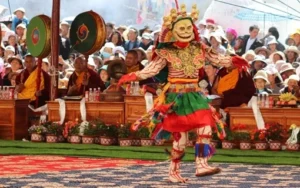Union Territory of Ladakh is located at the northernmost point of India, adjacent to the vast region of Tibet. The folk dances of Ladakh are heavily influenced by Tibetan Buddhism and are characterized by graceful moves, drums, and many other indigenous musical instruments, colorful dresses, and masks. Here is a list of some popular folk dance forms associated with Ladakh.
Folk Dance Styles Of Ladakh
1. Cham Dance

Cham Dance is a part of the traditional Buddhist celebrations in Ladakh. The dance movements depict various events from the life of Padmasambhava, a Nyingmapa educator in the 9th century. The performer wears a colourful shroud and a mask. As per Buddhist beliefs, witnessing Cham Dance brings good luck to the viewer. Cham Dance is one of the highlights of Tscehu event.
2. Matho Nagrang Dance
Matho Nagrang Dance is performed every year during Matho Nagrang celebrations, a Matho religious community festival. This is a concealed or covered dance form in which the dancers wear long covers depicting various divinities and animals from the folklore. The dance movements recreate stories from Buddhist traditions.
The brightly colored covers and props, synchronized movements, and soothing music create a divine atmosphere for the audience.
3. Drugpa Rches
Drugpa Rches is a folk dance form associated with the nomadic community called Dards, which is based in the Drass and Gorkhan areas of Ladakh. The performers wear colorful costumes adorned with flowers, silver ornaments, and unique masks. The dance movements are made to the tunes of large-sized drums known locally as Daman and Surna.
4. Surahi Dance
Surahi Dance is a highly energetic and lively folk dance form that is integral to Ladakhi culture and traditions. It is based on Surahi, a vessel storing and serving water. The dance movements mimic the pouring of water from a Surahi. The extremely fluid and synchronized movements depict the flowing of water. There are spiritual underpinnings of this dance form as well.
5. Lama’s Dance
Lama’s Dance, as the name indicates, is performed by the monks of the Buddhist monasteries in Ladakh called Lamas. It is mainly performed during the festival of Losar or the Buddhist New Year. The dance movements depict the struggle between good and evil, with masks acting as the differentiators. The Dance also integrates many elements from Tantrik Buddhism.
Lama’s Dance is characterized by visually stunning decorations and a divine and spiritual atmosphere created by the Lamas.
6. Shone Dance
Shone Dance captures the various aspects of life in Ladakh and stories from the Ladakhi folklore. The performers wear visually appealing outfits with handwoven textures, mirror work, and other decorations. The outfits are modelled on various themes such as leaves, blossoms, snowflakes, sceneries of Ladakh, and more. The blend of musical movements and dazzling outfits creates a magnificent atmosphere for the beholders.
7. Jabro Dance
The womenfolk of Ladakh traditionally perform the Jabro Dance. The women dancers form a line or circle and make perfectly synchronized body movements, hand developments, and footwork to the tunes of music and singing. The performers wear bright dresses, trimmings, and multiple kinds of masks. Musical tunes are generated using traditional instruments such as daman, dap, and surna.
8. Koshan Dance
Koshan Dance is performed in the Leh region of Ladakh. The unique feature of this dance form is that it is performed during horse riding festivals. The movements of this dance form are slow and pleasant. The traditional ornament worn by the dancers is known as Perak, which is a silver ornament. Rich music accompanies Koshan dance performances.
Santosh Kumar is a Professional SEO and Blogger, With the help of this blog he is trying to share top 10 lists, facts, entertainment news from India and all around the world.





